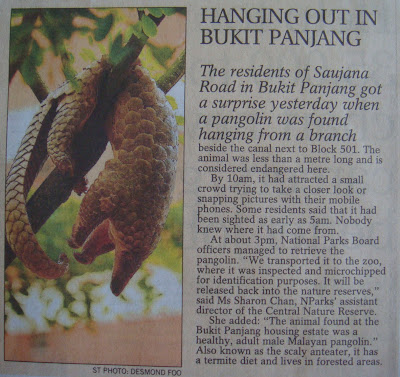What is biological conservation? It is the conservation of biodiversity which is the full spectrum of living organisms and the variability of nature. The aim of biological conservation is to maintain the diversity of living organisms and their environments and also the interactions between the two.
Why is it important? I was casually asking a few of my friends whether they think biological conservation was important and I was actually quite rather surprised with their replies. I cannot remember exactly what they told me but roughly along the lines of morality, education and religion.
Hanes was telling me that it was
morally right to protect biodiversity. That nature has its intrinsic value whether or not they bring us benefits.
Zhixin was going along the lines that such conservation is essential for
education and also to ensure future generations get to enjoy nature.
Huanyan asked me whether God would want us to conserve the biodiversity and it made me think for a while. For this is not an issue that organized
religion focus a lot on. We might talk about cloning, or abortion, but biological conservation of species? It's not something discussed as a ethical or moral issue in my religion. So I talked about stewardship. I told Huanyan that that I believed God would want us to take care of the things we have on earth, not to be irresponsible and destructive to the things we own.
Other than education, moral and religious motivations towards biological conservation, people desire to conserve also for nature's aesthetic values, ecological and utilitarian reasons.
I for one would purely conserve because nature is
beautiful. It's not everyday that I remember to smell the flowers or follow the outline of a fern, but when I do, it's one of the most amazing experience. Talking to birds and plucking wildflowers/weeds and just taking in deep breaths of fresh air, whether humid rain forest air, or salty mudflats or rotten mangrove wafts, they have therapeutic rewards for those who would only slow down and just for a moment appreciate the wonders of life.
Recently I took a video of mudskippers fighting and in courtship. It was fascinating trying to interprete what they were trying to do. And amazing that I could have a bird's eye view to capture that scene from the broadwalk of Sungei Buloh Wetland Reserve.
Other people conserve because biodiversity is a
utility, a resource for food, medication, research inspiration and other needs Mankind might have.
Still others who are more farsighted conserve because biodiversity plays an important role in maintaining the environment, whether ecosystems or climate. When we remove the living organisms that interact with their habitat, we are unknowingly supporting threats like global warming, landslides, harmful weather conditiions and CO2/O2 imbalances. Because both the biotic (living) and abiotic (non-living) factors are required to interact in meaningful ways to maintain our
ecological systems.




